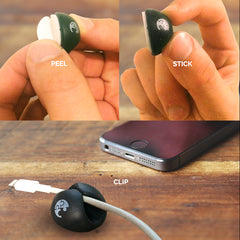Sign up here to get 20% off on your next purchase, special offers and other discount information

Cable clips are a wonderful tool used for cable management and can be attached to almost any surface. They help to organize cable clutter by bundling cables together and directing them away and out of sight. This prevents your cables from becoming tangled or damaged. This wire holder also helps to keep your children, pets, and electronics safe from harm.
When it comes to securing cables and wires in an industrial environment, the design and size of cable clips are especially crucial components to consider. Available in different types, styles, and sizes, cable clips are used to secure the clip to the machine or equipment, providing a highly necessary feature in ensuring communication and power flow in the area. Stainless steel is a popular choice for cable clips, especially in environments where corrosion-resistant material is highly desirable. Zinc plated and galvanized steel are also resistant to corrosion, making them a top choice for electrical machinery and equipment.
A cable clip can be installed using nails or screws into hard surfaces like wood, stone or brick. Plastic retainers can be used in stone and brick to attach the screw securely in place. Adhesives have a wide range of applications and can attach wire clips universally to nearly any surface. This type of material can also be used on virtually any surface such as walls, desks, nightstands, entertainment centers or cabinetry. Lastly, magnets can be used on metal surfaces and are surprisingly strong. These are excellent because they do not leave any residue or holes behind when removed. One advantage of using cable clips is that they can hold wires securely without the necessary use of a hammer or other tools. For instance, a single video cable can be held firmly in place with a zinc-plated fastener, providing a grip that ensures the cable will not move. In addition, cable clips typically feature a top grip that allows the user to quickly and easily route the cable in the necessary direction. This is especially important in industrial applications where quick installation is necessary to keep machinery running smoothly.
Learning how to properly install cable clips is also an important aspect of their use. For instance, it is necessary to check the size of the clip to ensure it is suitable for the cable or wire being secured. Once you have determined the appropriate size, the next step is to decide on the style of the clip. Stainless steel is highly recommended for industrial applications due to its resistance to corrosion, but zinc-plated and galvanized options are also available. For instance, a stainless steel cable clamp can be used to hold electrical wiring in place, providing a highly necessary feature in ensuring power flow in the area.
It is easy to organize your cords yourself with cable organizers! Take a look at where your cables need to go. You can use a cable sleeve to bundle together a lot of cords. You can also direct your cables behind furniture, under cabinetry or along baseboards to keep them out of sight and out of harm’s way. Some cable clips can hold a few cords whereas others may only hold one. Choose the correct clip based on how many cords you are needing to hide and the surface it will be attached to.
You can attach cable clips to the underside of your desk to securely hold cables that need to be within arm’s reach. Your cables will be easily accessible without cluttering up your workspace.
Another important factor to consider is the environment in which the clips are being used. For instance, if the area is highly prone to corrosion, it is important to choose a stainless steel or galvanized clip that is resistant to rust and other forms of corrosion. Additionally, the finish of the clip is also an important consideration. A quick and convenient way to route and install your cables is to use cable clips that feature a highly durable finish. This ensures that they will remain in place and provide necessary support for your cables for the long term.
Start by de-tangling your existing cords. Make sure that no cords are wrapped around another one and that they are all hanging freely. You can then begin using cable ties to direct them towards the backside of your desk. Once you get them into a bundle you can use a cable sleeve to neatly bundle them. Afterward, it’s important to bundle any excess cable. You can do this by wrapping it around your hand until there is only a little slack and then using zip ties to secure the unused cable.
In summary, cable clips are an essential component in industrial applications where communication and power flow are necessary. They provide a highly necessary feature in securing wires and cables to machinery and equipment without the use of a hammer or other tools. Whether you need to cancel and sign for a single video cable or hold electrical wiring in place, cable clips are a quick and efficient way to get the job done. Choosing the appropriate size, style, and finish is highly recommended for ensuring a secure and long-lasting installation that will keep your equipment running smoothly for years to come.
A cable clip is an effective, simple and cheap method of managing your cables. The important thing is to buy the correct cable clips for the number of wires you have and the surface you’ll be attaching them to. Some cable clips allow you to easily access your wires if you need to change them around. Others will need to be cut open and replaced if you need to make alterations. Choosing the right clips for the job will ensure that your cables are safe and out of sight!